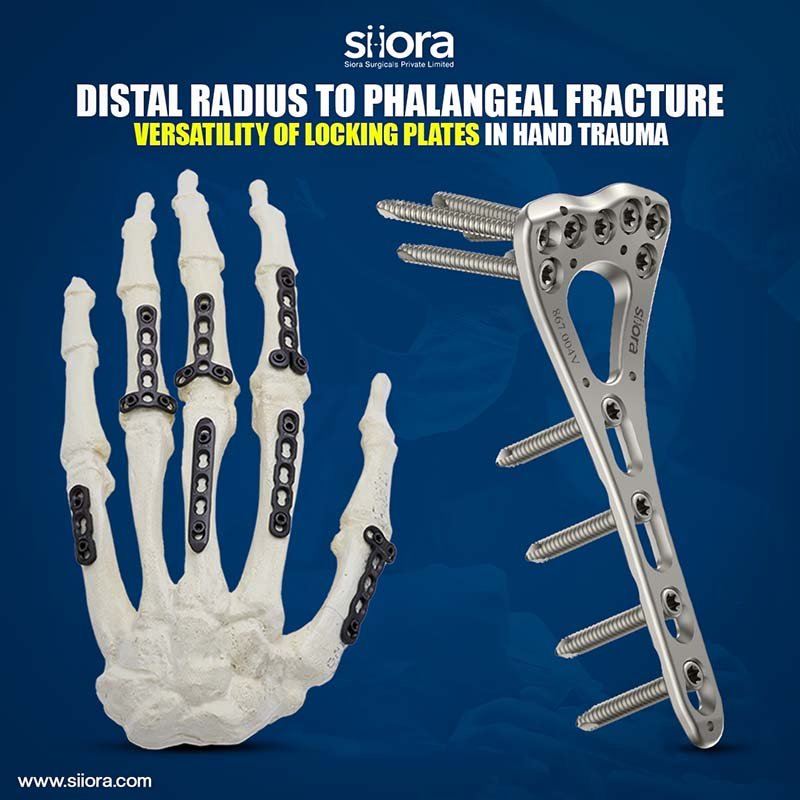Hand injuries, especially fractures, are not only common but also often life-altering. Whether it’s a sports-related fall, industrial accident, or a simple household mishap, the consequences can severely impact daily life and occupational function. Among these, fractures ranging from the distal radius down to the phalanges are some of the most frequent, and managing them requires precision, stability, and early mobilization. In recent years, locking plates, especially those designed as hand plates and radius plate systems, have revolutionized the management of hand trauma, offering a reliable, versatile solution for fracture fixation.
Understanding Hand Fractures
The human hand is a marvel of anatomy; compact, intricate, and incredibly functional. It consists of 27 bones: the carpal bones (wrist), metacarpals (palm), and phalanges (fingers). Among these, distal radius fractures and phalangeal fractures are the most commonly reported in emergency rooms.
- Distal radius fractures typically occur just above the wrist and often result from falls on an outstretched hand.
- Phalangeal fractures, on the other hand, are frequently caused by crush injuries, direct trauma, or sports incidents.
Historically, many of these fractures were managed conservatively with casting. However, the need for anatomical alignment, especially in intra-articular or displaced fractures, led to the development of surgical options. This is where locking hand fracture plates have proven invaluable.
What Makes Locking Plates So Effective?
Unlike traditional plates that rely solely on friction between the plate and the bone, locking hand plates feature screws that lock into the plate itself, creating a fixed-angle construct. This provides numerous benefits in hand trauma care:
- Enhanced stability even in osteoporotic or small bones
- Preservation of blood supply due to minimal plate-to-bone compression
- Faster rehabilitation, thanks to early mobilization post-surgery
Because of these advantages, locking hand system has become the gold standard in many orthopedic centers, especially for complex or unstable hand fractures.
Distal Radius Fractures: A Case for Radius Plates
When it comes to wrist trauma, distal radius fractures are at the forefront. These fractures often involve the joint surface and require precise realignment to prevent long-term complications like arthritis, stiffness, or deformity.
Radius plates, particularly volar locking plates, have become the go-to fixation method for such injuries. Their design allows for:
- Secure fixation on the volar (palm-facing) side of the radius
- Angular stability through locking screws
- Minimal soft tissue disruption
Modern locking hand systems are also anatomically contoured to match the natural curvature of the radius, reducing the risk of irritation or tendon damage. Whether treating a simple extra-articular fracture or a complex comminuted break, the adaptability of these plates makes them indispensable.
Phalangeal Fractures: Precision Fixation with Hand Plates
Phalangeal fractures, especially those involving the proximal and middle phalanges, present unique challenges. The small size of the bones, proximity to tendons, and limited soft tissue coverage demand careful surgical planning. That’s where the plate for hand fracture truly shines.
Using low-profile hand plates, surgeons can achieve:
- Accurate realignment of fracture fragments
- Stable fixation without compromising tendon function
- Early range-of-motion exercises prevent joint stiffness
Locking hand fracture plates are especially helpful in comminuted fractures or segmental bone loss, where traditional screws may not provide enough grip. Additionally, these plates are designed with multiple hole options, allowing surgeons to customize fixation according to the fracture pattern.
Versatility Across the Spectrum of Hand Trauma
One of the standout features of locking plates is their versatility. A single system can be adapted across various hand injuries, from the distal radius to the tiny phalanges. Modular hand plate systems often include:
- Plates of various lengths and widths
- Angled and straight designs
- Special options for metacarpal and thumb fractures
This adaptability reduces surgical time, minimizes inventory needs, and ensures consistency in outcomes. Moreover, the use of titanium or stainless-steel alloys makes these plates biocompatible, lightweight, and durable.
Post-Operative Advantages of Locking Hand Fracture Plates
One of the biggest shifts in orthopedic care has been the emphasis on early rehabilitation. Unlike traditional fixation methods that required prolonged immobilization, locking hand plates enable early motion, which is crucial in the hand.
Benefits include:
- Reduced joint stiffness
- Faster return to function
- Improved patient satisfaction
Many patients are able to begin physiotherapy within days of surgery, dramatically improving long-term hand strength and mobility. The rigidity of the locked construct gives both the patient and surgeon confidence in the fixation.
Challenges and Considerations
While locking plates offer multiple advantages, their success depends on proper application. Some key considerations include:
- Surgical skill and experience: Precision is vital when placing plates near tendons or joints.
- Plate selection: Choosing the correct size and shape for each fracture type is essential.
- Patient compliance: Post-surgical care, including wound management and physiotherapy, plays a vital role in outcomes.
Furthermore, cost can be a factor in some healthcare systems. However, the long-term benefits, reduced complications, shorter recovery times, and better functional outcomes often outweigh the initial investment.
Looking Ahead: Innovation in Hand Plate Design
The field of orthopedic implants continues to evolve. New generations of hand fracture plates are even thinner, more contoured, and come with variable-angle locking screw options. Some systems are now incorporating hybrid designs that allow both locking and non-locking screws in the same plate, giving surgeons even more control over fixation strategy.
Additionally, patient-specific solutions using 3D imaging and printing are on the horizon, promising even more personalized care for complex fractures.
Conclusion
From the robust radius plate used to stabilize a shattered wrist to the fine-tuned hand plate that holds a delicate phalanx together, locking plates have redefined the management of hand trauma. Their adaptability, strength, and support for early mobility make them an essential tool in the orthopedic arsenal.
For patients, this translates into faster recoveries, fewer complications, and a better chance of returning to their normal lives. For surgeons, it offers confidence and flexibility in tackling even the most challenging fractures.
As the technology continues to evolve, one thing remains clear: locking hand fracture plates are here to stay, and they’re making broken hands whole again, one plate at a time.






